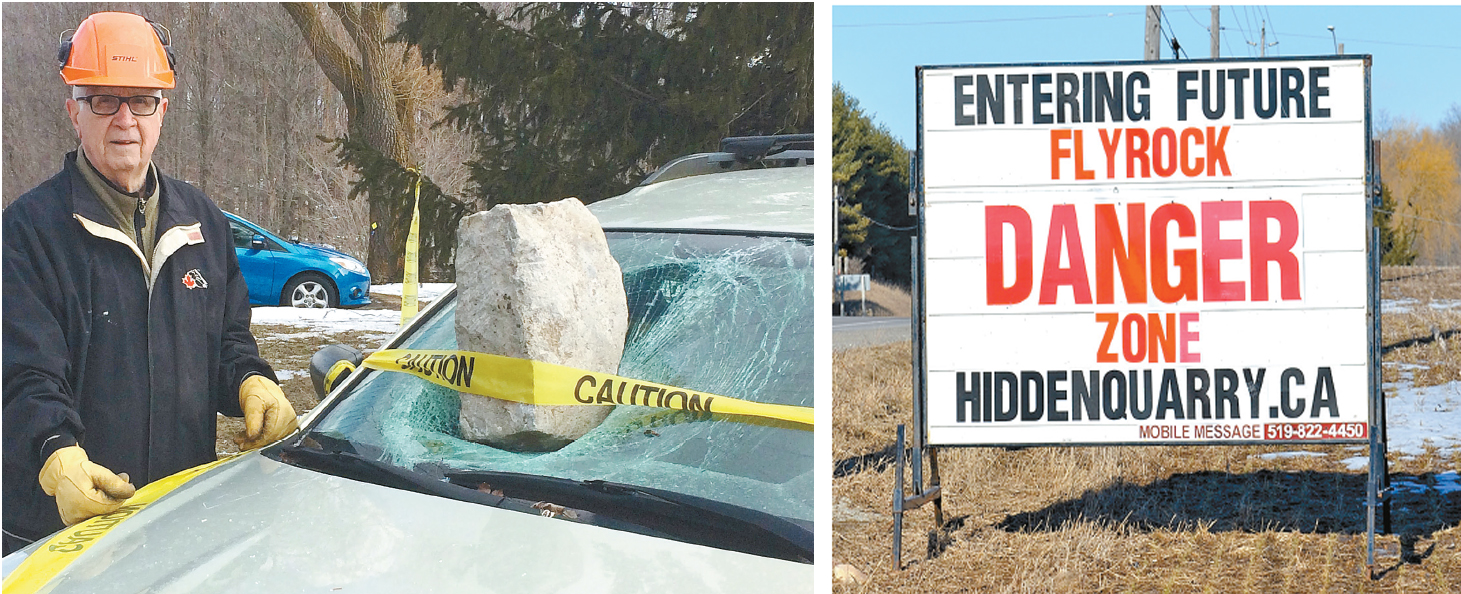ROCKWOOD – Drivers on Highway 7 east of Rockwood could be hit by flying boulders if the “hidden quarry” is allowed to proceed, according to the Concerned Residents Coalition (CRC).
The group set up signs on March 18 warning of a “future flyrock danger zone” and called on Ontario to enact a 500-metre blasting exclusion zone to protect residents and drivers. It’s the latest tactic in an ongoing struggle with pit proponent James Dick Construction Ltd. (JDCL).
Company vice president Greg Sweetnam strongly denies the CRC’s claim and accuses the group of “fundraising by terror”.
“We’d be out of business if we had flyrock coming out of that quarry,” said Sweetnam. “All of the blasts are designed so that we do not have flyrock.”
To dramatize their point, CRC members put a car on display at a home across the road, just 75 metres from the proposed quarry, staged with a limestone boulder through the windshield.
“A tragic event like this can be prevented if John Yakabuski, minister of natural resources and forestry, decrees a flyrock exclusion zone of at least 500 metres on the proposed hidden quarry, and all aggregate sites in Ontario,” said Harry Wilson, a member of the CRC board.
“Flyrock fragments propelled at up to 600 kilometres per hour by explosive detonations have caused property damage, personal injury and deaths around the globe.
“The probability of flyrock being thrown outside a quarry site is low, but it is not zero.”
In an interview, Sweetnam argued that the extremely low risk of flyrock will be even lower since JDCL intends to blast underwater, at the bottom of a gravel pit.
“This is a real long shot,” he said. “You are in far more danger driving your car down the road. The chances of having an automobile accident are probably a million times more dangerous than getting harmed by any flyrock.
“We have a 54-year history in Ontario. We’ve never had an incident of flyrock from any of our quarries [including above-water]. There’s many, many quarries along provincial highways in Ontario that have never had flyrock incidents.”
The CRC says while flyrock is rare, an incident could be catastrophic. They point to other jurisdictions that have exclusion zones that prohibit blasting within a minimum distance from homes. Wilson said it is 800 metres in Nova Scotia, but there is no set minimum in Ontario.
Susan Haslem of Rockwood was at the March 18 demonstration and recounted a flyrock incident that happened more than 10 years ago. She was playing golf near Acton when a blast from a nearby quarry sent several pieces of rock about the size of a microwave onto the course. No one was hurt.
CRC officials say flyrock pieces as large as one cubic foot have been propelled as far as 1.2km from a blasting site.
The quarry would be about 1.4km due east of Rockwood streets. The CRC says an average of 9,000 vehicles travel the highway between Rockwood and Acton every day.
“CRC has been assessing the application since 2013 and have found it fraught with risks to our communities and environment,” said CRC spokesperson Linda Sword.
The quarry licencing and re-zoning applications will be reviewed at a Local Planning Appeal Tribunal (LPAT) hearing scheduled to begin May 21.
Issues include the possible contamination of groundwater, levels of noise and dust, impact on wildlife and wetlands, the effects of seismic vibrations on the foundations of heritage buildings and the risk of flyrock.
“It’s lunacy putting a pit there, 75 meters away,” said Bill Hill, a mine blasting expert who has worked with the CRC to review studies commissioned by JDCL.
“You’d have to have the highway closed off and have guards out here telling people to get into a basement under a cement floor.”
Sweetnam said JDCL hired Explotech from Ottawa, a leading blasting firm, to do the blasting design at the site.
“At the request of the CRC, we got [the Explotech] work peer reviewed by Golder Associates, and they’ve also said that we’ve done everything correct,” said Sweetnam.
CRC has countered that review with an analysis by Hill, who said the Golder review lacked detail and critical investigation.
“You just can’t keep the CRC happy,” said Sweetnam. “They’re on the sleighride into this hearing, and they’re just trying anything to raise funds from the public.
“This is the latest in their campaign of what I call fundraising by terror; ways that they call attention to their cause by just scaring the public. They did it with radon gas, and then they abandoned that issue. I guess the current issue is flyrock.”
Hill said while aggregate companies are required to report any flyrock projected off their property, they do not always do so.
The CRC has published a list of flyrock events in Ontario, in other provinces and internationally, including the deaths of two car passengers, one on U.S. Interstate 75 and the other on Britain’s M1 motorway.
CRC officials say even with precautions by the company, geological factors and human error could cause flyrock.
They estimate there could be 25,000 to 75,000 separate explosive charges during the quarry’s proposed 17-year operating life, with eight to 25 flyrock incidents per year, including some in which flyrock makes it off the CRC property.




